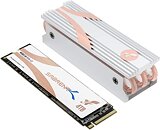Wednesday, July 22nd 2020
Sabrent Showcases World's First 4 TB PCIe 4.0 NVMe SSD
Sabrent, an American hardware manufacturer, has recently started breaking records with the world's first everything. Starting from the recent 8 TB PCIe 3.0 NVMe SSD that comes in M.2 format, Sabrent doesn't plan to stop there. Thanks to the keen eyes of folks over at TweakTown, we have found out that Sabrent has prepared to launch the new Rocket Q4 SSD which is a PCIe 4.0 NVMe monster. Coming in the capacity of 4 TB, the company has built the world's first 4 TB PCIe 4.0 NVMe SSD.
When it comes to specifications of the SSD, it can reach some quite impressive speeds. When writing, it reaches 3500 MB/sec (3.5 GB/sec), and in the reading, it can reach up to 4900 MB/sec (4.9 GB/sec). Now imagine putting two of these in RAID 0. Nonetheless, we don't know what controller the company is using for this model. The NAND chips used are QLC based. But you are now wondering about the price of it. The purchase of this SSD will set you back $770 with a heatsink or $750 without one. You can purchase the SSD here.
Source:
TweakTown
When it comes to specifications of the SSD, it can reach some quite impressive speeds. When writing, it reaches 3500 MB/sec (3.5 GB/sec), and in the reading, it can reach up to 4900 MB/sec (4.9 GB/sec). Now imagine putting two of these in RAID 0. Nonetheless, we don't know what controller the company is using for this model. The NAND chips used are QLC based. But you are now wondering about the price of it. The purchase of this SSD will set you back $770 with a heatsink or $750 without one. You can purchase the SSD here.

21 Comments on Sabrent Showcases World's First 4 TB PCIe 4.0 NVMe SSD
"Manufacturers of SSD systematically switch to the use of 64-layer flash memory and WD Blue 3D NAND reflects this trend with BiSC3 chips developed by the joint venture of Toshiba and Western Digital. However, the endurance of the new version of Western Digital Blue 3D NAND turned out to be dramatically low: this drive not only could not transfer the recording of the volume declared under the guarantee conditions, but also set a new low reliability record of just 82 TB. And by the way, this is not the first example when the 64-layer BiSC3 chips are criticized. It seems that this type of flash memory is not very suitable for working in solid-state drives for PCs, and Toshiba and Western Digital are somewhat in a hurry with the widespread introduction of their three-dimensional NAND. The demise of WD Blue 3D NAND was preceded by the occurrence of multiple problems in the flash memory array, which began to manifest themselves after writing just 54 TB of data to the drive. The average number of flash rewrite cycles that BiCS3 was able to transfer to WD Blue 3D NAND during its life cycle was only 345. As a result, it remains only to marvel at how such an unreliable product, like WD Blue 3D NAND, was able to enter the market. Having tested the resource of more than four dozen different SSDs, we still have not encountered anything like it"
Same goes for tech sites acting like junior marketing interns for cheering on replacing HDD's with SSD's for external cold storage. Here's what the read speeds on a "550MB/s" Samsung 850 EVO looks like after 329 days of being continuously unpowered (as low as 15MB/s) when used as an external backup drive due to extreme error correcting measures trying to "guestimate" back the data it wrote vs the voltage drift. It's way past time we saw some serious grown-up articles from tech sites actually re-testing endurance & unpowered retention on the newer QLC's beyond just quoting marketing brochures, as I wouldn't touch QLC drives with a barge-pole as "replacements" for external spinners.
need...
like...
10 of them...\
like....
yesterday....:roll:
QLC gets a bad name when you compare it to the endurance of newer more expensive drives for professionals who use them to write and rewrite many times per week.
But objectively, most of these QLC drives promice 350 or more TERABYTES of writing BEFORE they possibly fail.
NO average user or gamer is going to do that many writes/ rewrites in 3 - 5 years.
In 5 years newer tech comes to market and you can UPGRADE to a newer, larger capacity, higher endurance, cheaper SSD.
I'm getting a single 8TB QLC drive for my desktop and moving one of my 2TB MX500 drives to my gaming laptop.
As for the professionals...many of them can easily afford better more expensive equipment because their career makes it affordable.
blog.synology.com/tlc-vs-qlc-ssds-what-are-the-differences
Hopefully by then, bigger drives will be available :)